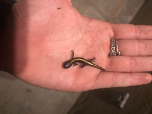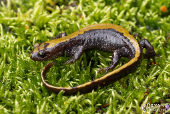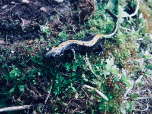Eastern Long-Toed Salamander (A. m. krausei)
Description: The Eastern Long-toed Salamander is dark grey to black with an irregular-edged bright yellowish dorsal stripe that that becomes a series of blotches on the head, snout and eyelids. There is often white speckling on the sides and the belly is grey or black. This salamander is named after the very long toe on the hind foot (second from the outside). Individuals have 12 to 13 costal groves and can grow up to 17 cm in total length. Aquatic larvae have feathery gills behind the head, legs (both front and back) and a tail fin and are generally brown or green with dark brown and black mottling.
Habitat: Eastern Long-toed Salamanders breed in permanent or semi-permanent lakes, ponds or wetlands that are fish-free. They inhabit a variety of terrestrial habitats within close proximity (usually within 100 m) of these breeding sites, including forest, meadows and grassland. Like many salamanders, areas with moist microhabitats are preferred. Logs, rocks and other cover objects, as well as underground burrows and crevices, are important microhabitats where the salamanders forage and seek shelter. Individuals overwinter underground below the frost line in rodent burrows, root hollows or other underground cavities
Range: In the United States, this subspecies occurs in eastern Washington, northeastern Oregon and northwestern Idaho.
Found in these States:
ID |
MT |
OR |
WA
Diet: Adults and juveniles eat insects, spiders, worms and other terrestrial invertebrates, while larvae prey on immature aquatic insects, microcrustaceans, tadpoles or other salamander larvae.
Reproduction: Long-toed Salamanders migrate to breeding sites on rainy nights in early spring, often before the ice has fully receded. Each female will attach up to 400 eggs singly or in small clumps of up to 30 eggs to submerged sticks or vegetation in shallow water. The eggs hatch into aquatic larvae after two to five weeks. At lower elevations the larvae transform into terrestrial juveniles by the end of summer, but at higher elevations where water temperatures are cooler the larvae may overwinter and transform the following spring. In Canada, Long-toed Salamanders reach sexual maturity in two to three years, and individuals may live up to 10 years.
Status: Listed as Least Concern in view of the large extent of occurrence, large number of subpopulations, presumed large population size, and use of a wide range of habitats.
»» Kingdom: Animalia - Animals
»» Phylum: Chordata - Chordates
»» Subphylum: Vertebrata - Vertebrates
»» Class: Amphibia - (Amphibians)
»» Order: Caudata - Salamanders
»» Family: Salamandridae - Newts
»» Subfamily: Pleurodelinae - Pleurodeline Newts
»» Genus: Ambystoma
»» Species: Ambystoma macrodactylum - Long-Toed Salamanders
»» Subspecies: A. m. krausei - Eastern Long-Toed Salamander
This article uses material from the Wikipedia article "Long-Toed Salamander", which is released under the Creative Commons Attribution-Share-Alike License 3.0. Content may have been omitted from the original, but no content has been changed or extended.
|













